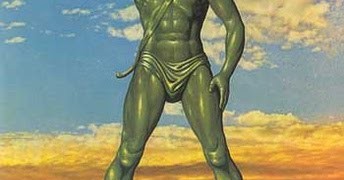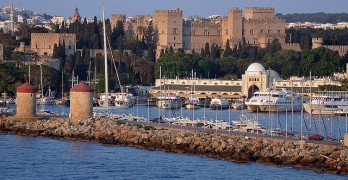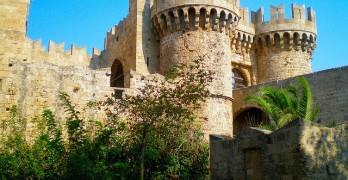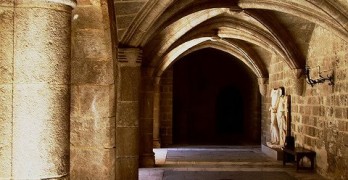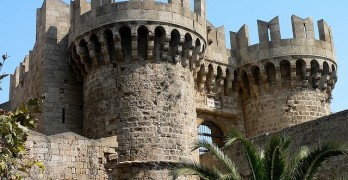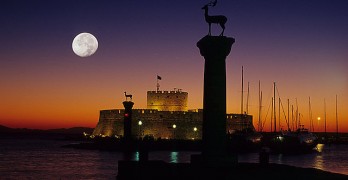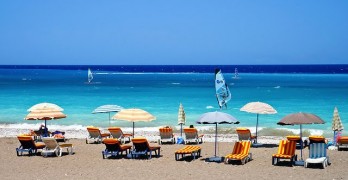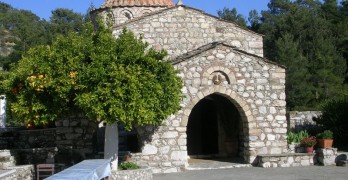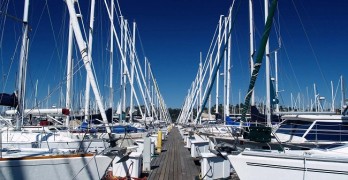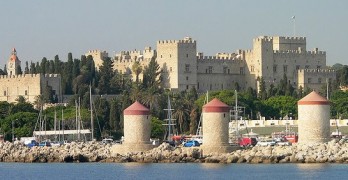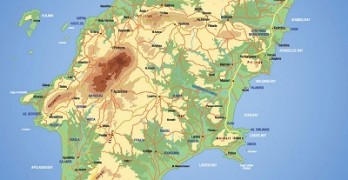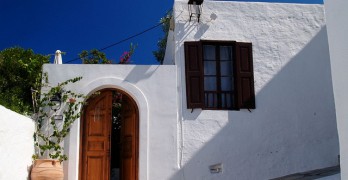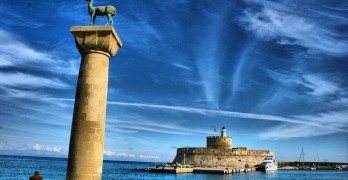 Colossus history: The island of Rhodes was an important economic center in the ancient world. It is located off the southwestern tip of Asia Minor where the Aegean Sea meets the Mediterranean. The capitol city, also named Rodos, was built in 408 B.C. and was designed to take advantage of the island’s best natural harbour on the northern coast.
Colossus history: The island of Rhodes was an important economic center in the ancient world. It is located off the southwestern tip of Asia Minor where the Aegean Sea meets the Mediterranean. The capitol city, also named Rodos, was built in 408 B.C. and was designed to take advantage of the island’s best natural harbour on the northern coast.
In 357 B.C. the island was conquered by Mausolus of Halicarnassus (whose tomb is one of the other Seven Wonders of the Ancient World), fell into Persian hands in 340 B.C., and was finally captured by Alexander the Great in 332 B.C..
When Alexander died of a fever at an early age, his generals fought bitterly among themselves for control of Alexander’s vast kingdom. Three of them, Ptolemy, Seleucus, and Antigous, succeeded in dividing the kingdom among themselves.
The Rhodians supported Ptolemy (who wound up ruling Egypt) in this struggle. This angered Antigous who sent his son Demetrius to capture and punish the city of Rhodes. The war was long and painful. Demetrius brought an army of 40,000 men. This was more than the entire population of Rhodes.
When Demetrius attacked the city, the defenders stopped the war machine by flooding a ditch outside the walls and mining the heavy monster in the mud. By then almost a year had gone by and a fleet of ships from Egypt arrived to assist the city. Demetrius withdrew quickly leaving the great siege tower where it was. To celebrate their victory and freedom, the Rhodians decided to build a giant statue of their patron god Helios.
They melted down bronze from the many war machines Demetrius left behind for the exterior of the figure and the super siege tower became the scaffolding for the project. According to Pliny, a historian who lived several centuries after the Colossus was built, construction took 12 years. Other historians place the start of the work in 304 B.C..
The statue was one hundred and ten feet high and stood upon a fifty-foot pedestal near the harbour mole. Although the statue has been popularly depicted with its legs spanning the harbour entrance so that ships could pass beneath, it was actually posed in a more traditional Greek manner: nude, wearing a spiked crown, shading its eyes from the rising sun with its right hand, while holding a cloak over its left.
The architect of this great construction was Chares of Lindos, a Rhodian sculptor who was a patriot and fought in defence of the city. Chares had been involved with large scale statues before. His teacher, Lysippus, had constructed a 60-foot high likeness of Zeus. Chares probably started by making smaller versions of the statue, maybe three feet high, then used these as a guide to shaping each of the bronze plates of the skin.
The Colossus stood proudly at the harbour entrance for some fifty-six years. Each morning the sun must have caught its polished bronze surface and made the god’s figure shine. Then an earthquake hit Rhodes and the statue collapsed. Huge pieces of the figure lay along the harbour for centuries.
It is said that an Egyptian king offered to pay for its reconstruction, but the Rhodians refused. They feared that somehow the statue had offended the god Helios, who used the earthquake to throw it down.
In the seventh century A.D. the Arabs conquered Rhodes and broke the remains of the Colossus up into smaller pieces and sold it as scrap metal. Legend says it took 900 camels to carry away the statue. A sad end for what must have been a majestic work of art.
RHODES ISLAND GREECE
Rhodes island Greece Rodos
 ΕΙΔΗΣΕΙΣ ΚΑΙ ΤΟΠΙΚΑ ΝΕΑ ΤΗΣ ΡΟΔΟΥ
ΕΙΔΗΣΕΙΣ ΚΑΙ ΤΟΠΙΚΑ ΝΕΑ ΤΗΣ ΡΟΔΟΥ
- Πέντε αιρετοί του Δήμου Ρόδου προσέφυγαν στο ανώτατο ακυρωτικό κατά των αποφάσεων εκπτώσεως τους λόγω οφειλών
- Εκδηλώθηκε ενδιαφέρον για τα καταστήματα στις Πηγές Καλλιθέας
- Συζητούνται 12 υποθέσεις ανάκλησης ή διακοπής λειτουργίας εμπορικών καταστημάτων
- Προγραμματίζεται η αναδάσωση και επαναφύτευση των πυρόπληκτων δασικών περιοχών
- Πολλά ρεκόρ στο Μαραθώνιο Ρόδου 2024 – Χιλιάδες δρομείς βίωσαν έναν εξαιρετικό αγώνα!
 ΞΕΝΟΔΟΧΕΙΑ ΡΟΔΟΣ ΦΘΗΝΑ ΠΡΟΣΦΟΡΕΣ
ΞΕΝΟΔΟΧΕΙΑ ΡΟΔΟΣ ΦΘΗΝΑ ΠΡΟΣΦΟΡΕΣ
- Ibiscus Hotel – Rhodes 2016Δείτε τις προσφορές που ισχύουν για την διαμονή σας στο Ibiscus Hotel στην Ρόδος για το έτος 2016 και διαβάστε μια σύντομη περιγραφή του ξενοδοχείου παρακάτω. Τσεκάρετε εάν υπάρχει κάποια διαθέσιμη ειδική προσφορά για σήμερα στο “booking.com” και κερδίστε έκπτωση εώς και 45%, κάντε την κράτηση σας απόψε. Στην πόλη της Ρόδου, λίγα λεπτά από […]
- Agla Hotel – Rhodes 2016Δείτε τις προσφορές που ισχύουν για την διαμονή σας στο Agla Hotel στην Ρόδος για το έτος 2016 και διαβάστε μια σύντομη περιγραφή του ξενοδοχείου παρακάτω. Τσεκάρετε εάν υπάρχει κάποια διαθέσιμη ειδική προσφορά για σήμερα στο “booking.com” και κερδίστε έκπτωση εώς και 45%, κάντε την κράτηση σας απόψε. Το Agla Hotel βρίσκεται σε μια ήσυχη […]
- Sentido Ixian Grand Hotel – Rhodes 2016Δείτε τις προσφορές που ισχύουν για την διαμονή σας στο Sentido Ixian Grand Hotel στην Ρόδος για το έτος 2016 και διαβάστε μια σύντομη περιγραφή του ξενοδοχείου παρακάτω. Τσεκάρετε εάν υπάρχει κάποια διαθέσιμη ειδική προσφορά για σήμερα στο “booking.com” και κερδίστε έκπτωση εώς και 45%, κάντε την κράτηση σας απόψε. Το παραθαλάσσιο Sentido Ixian Grand […]
- Athena Hotel – RhodesΔείτε τις προσφορές που ισχύουν για την διαμονή σας στο Athena Hotel στην Ρόδος και διαβάστε μια σύντομη περιγραφή του ξενοδοχείου παρακάτω. Τσεκάρετε εάν υπάρχει κάποια διαθέσιμη ειδική προσφορά για σήμερα, κερδίστε έκπτωση εώς και 45%, κάντε την κράτηση σας απόψε. Το Athena Hotel είναι ένα μοντέρνο ξενοδοχείο στην καρδιά της πόλης της Ρόδου, μόλις […]
- Sun Beach Resort Complex – RhodesΔείτε τις προσφορές που ισχύουν για την διαμονή σας στο Sun Beach Resort Complex στην Ρόδος και διαβάστε μια σύντομη περιγραφή του ξενοδοχείου παρακάτω. Τσεκάρετε εάν υπάρχει κάποια διαθέσιμη ειδική προσφορά για σήμερα, κερδίστε έκπτωση εώς και 45%, κάντε την κράτηση σας απόψε. Το Sun Beach Resort Complex βρίσκεται επάνω στην παραλία της Ιαλυσού, σε […]
 ΟΡΘΟΔΟΞΗ ΡΟΔΟΣ
ΟΡΘΟΔΟΞΗ ΡΟΔΟΣ
- Η Θεία Λειτουργία είναι η μεγαλύτερη πνευματική ελεημοσύνη παγκοσμίως
- Άγιος Εφραίμ Κατουνακιώτης: «Βρε, τον Χριστόδουλο! Μεσ’ την χαρά του παραδείσου είναι»!
- ΑΡΓΙΕΣ 2024: Πότε πέφτει η Μεγάλη εβδομάδα και το Άγιο Πάσχα
- Άγιος Γλυκέριος ο γεωργός (23 Απριλίου)
- Μεγάλη Εβδομάδα: Έθιμα και παραδόσεις του Πάσχα
 ΠΡΟΣΦΟΡΕΣ ΣΟΥΠΕΡΜΑΡΚΕΤ ΡΟΔΟΥ
ΠΡΟΣΦΟΡΕΣ ΣΟΥΠΕΡΜΑΡΚΕΤ ΡΟΔΟΥ
- ΒΑΣΙΛΟΠΟΥΛΟΣ 15-04-2016Οι προσφορές των Σούπερ Μάρκετ ΑΒ ΒΑΣΙΛΟΠΟΥΛΟΣ ισχύουν από: 07 Μαρτίου έως 23 Μαρτίου, δείτε το νέο φυλλάδιο πατώντας – ΕΔΩ ΡΟΔΟΣ ^ ΠΛΗΡΟΦΟΡΙΕΣ – ΚΑΤΑΣΤΗΜΑΤΑ “ΑΒ ΒΑΣΙΛΟΠΟΥΛΟΣ”
- ΜΑΡΙΝΟΠΟΥΛΟΣ CARREFOUR 12-04-2016Οι προσφορές των Σούπερ Μάρκετ CARREFOUR ΜΑΡΙΝΟΠΟΥΛΟΣ ισχύουν από: 12 Απριλίου έως 31 Απριλίου, δείτε το νέο φυλλάδιο πατώντας – ΕΔΩ ΡΟΔΟΣ ^ ΠΛΗΡΟΦΟΡΙΕΣ – ΚΑΤΑΣΤΗΜΑΤΑ “CARREFOUR ΜΑΡΙΝΟΠΟΥΛΟΣ”
- LIDL 14-04-2016Οι προσφορές των Σούπερ Μάρκετ LIDL ισχύουν από: 14 Απριλίου έως 31 Απριλίου, δείτε το νέο φυλλάδιο πατώντας – ΕΔΩ ΡΟΔΟΣ ^ ΠΛΗΡΟΦΟΡΙΕΣ – ΚΑΤΑΣΤΗΜΑΤΑ “LIDL”
- ΦΛΕΒΑΡΗΣ 28-03-2016Οι προσφορές των Σούπερ Μάρκετ ΦΛΕΒΑΡΗΣ ισχύουν από: 28 Μαρτίου έως 06 Απριλίου, δείτε το νέο φυλλάδιο πατώντας – ΕΔΩ ΡΟΔΟΣ ^ ΠΛΗΡΟΦΟΡΙΕΣ – ΚΑΤΑΣΤΗΜΑΤΑ “ΦΛΕΒΑΡΗΣ”
- ΠΑΝΑΓΙΩΤΑΣ 01-04-2016Οι προσφορές των Σούπερ Μάρκετ ΠΑΝΑΓΙΩΤΑΣ ισχύουν από: 01 Απριλίου έως 16 Απριλίου, δείτε το νέο φυλλάδιο πατώντας – ΕΔΩ ΡΟΔΟΣ ^ ΠΛΗΡΟΦΟΡΙΕΣ – ΚΑΤΑΣΤΗΜΑΤΑ “ΠΑΝΑΓΙΩΤΑΣ”
 ΤΕΧΝΟΛΟΓΙΑ
ΤΕΧΝΟΛΟΓΙΑ
- Η Μόνα Λίζα «τραγουδά» ραπ με τη βοήθεια της Τεχνητής Νοημοσύνης της Microsoft
- Watch Dogs: Οριστικό τέλος στη σειρά βάζει η Ubisoft, ακυρώθηκε μέχρι και battle royale project
- Εξέταση αίματος τεχνητής νοημοσύνης εντοπίζει γρήγορα δύσκολα ανιχνεύσιμους καρκίνους
- Samsung Galaxy Ring: Leak αποκαλύπτει ότι θα έρθει σε 8 διαφορετικά μεγέθη
- Η Microsoft διευκολύνει την εγκατάσταση εφαρμογών από το Windows Store για web browsers
 ALARM
ALARM
- ΑΝΑΚΟΙΝΩΣΗΤο alarm.rodos-island.gr ανακοινώνει οτι θα πάψει την λειτουργία του διότι μηνύθηκε για διασπορά ψευδών ειδήσεων (ρατσιστικό έγκλημα) εξαιτίας μίας αναδημοσίευσης απο έναν έγκυρο ιστότοπο-εφημερίδα η οποία έγινε 24 Δεκεμβρίου 2019. Ώς διαχειριστής λυπάμαι πολύ και ζητάω συγνώμη άν ενόχλησε ή μείωσε ή έβλαψε κάποιον-ους άθελα μου, οι αναδημοσιεύσεις που γίνονταν αυτόματα μέσω rss feed απο […]
 ΥΓΕΙΑ
ΥΓΕΙΑ
- Ελλείψεις φαρμάκων: Η επένδυση που δίνει τη λύση σε Ελλάδα και Ευρώπη
- ΕΟΔΥ: Που γίνονται δωρέαν rapid test για τον κορονοϊό, σήμερα 23 Απριλίου
- Πώς επηρεάζει η αφρικανική σκόνη τα ζωτικά όργανα και το ανοσοποιητικό
- Η κατανάλωση υπερ-επεξεργασμένων τροφίμων αυξάνουν τη λοίμωξη από Ελικοβακτηρίδιο
- Αυτή είναι η καλύτερη προπόνηση με βάρη
 GOSSIP
GOSSIP
- Σταματίνα Τσιμτσιλή σε Δημήτρη Παπανώτα: Υπήρξες προσβλητικός απέναντι στη Μπέττυ Μαγγίρα
- Σελίν Ντιόν: Η εντυπωσιακή φωτογράφιση & η συγκλονιστική εξομολόγηση: «Ελπίζω σε ένα θαύμα»
- Νίκη Κάρτσωνα: Κηπουρική με τον γιο της – Ανανέωσαν τα φυτά στα παρτέρια
- Concealer Sandwich: Η τεχνική που καλύπτει αποτελεσματικά τα ενοχλητικά σπυράκια στο πρόσωπο
- Τατιάνα Λύγαρη: «Διευθυντής θεάτρου ήπιε κόκκινο κρασί από το γοβάκι μου»
